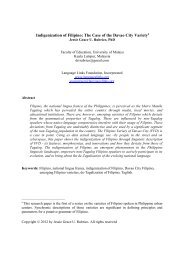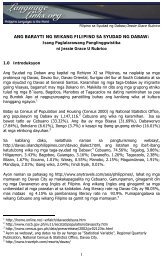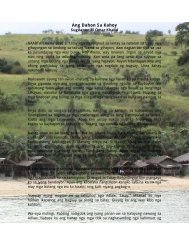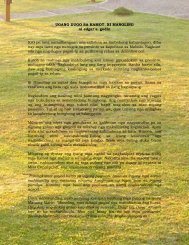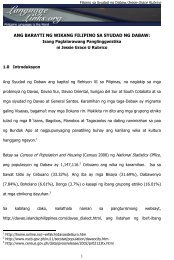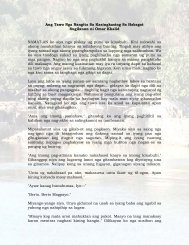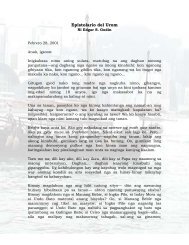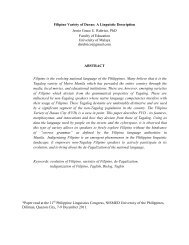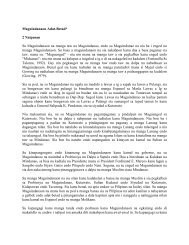Language and Culture - Languagelinks.org
Language and Culture - Languagelinks.org
Language and Culture - Languagelinks.org
You also want an ePaper? Increase the reach of your titles
YUMPU automatically turns print PDFs into web optimized ePapers that Google loves.
<strong>Language</strong> <strong>and</strong> <strong>Culture</strong> iDr. Jessie Grace U. Rubrico<strong>Culture</strong> is a social construct that binds a group of people with shared ideals, values, attitudes, goals <strong>and</strong>way of life. It is acquired through membership in a particular group or society. It defines the world viewof the people in its domain. It molds their concepts, perceptions, <strong>and</strong> outlook. It bestows upon them anidentity fostered through the years <strong>and</strong> h<strong>and</strong>ed down from one generation to the next. These worldview <strong>and</strong> identity are anchored on things which unite them <strong>and</strong> strengthen their bond as a peopletheirbeliefs, way of thinking, aspirations, customs <strong>and</strong> traditions, heritage <strong>and</strong> determination. Eachperson is nurtured in a culture which initiates him or her into the different roles that he or she isexpected to play in society in a manner that conforms to its norms. This culture is one’s roadmap tocharting a journey towards a fruitful <strong>and</strong> satisfying life.<strong>Culture</strong> is embodied, expressed <strong>and</strong> h<strong>and</strong>ed down through language. While children are learning theirnative language, they are also gradually acquiring their culture. The words in the lexicon of a languageare a strong indication of its people’s way of life <strong>and</strong> world view. For example, each group of peoplehas its own terminology in reckoning time: the farmers, through planting <strong>and</strong> harvest seasons; factoryworkers, count eight hours each day <strong>and</strong> wait for payday; <strong>and</strong> students consider time in terms ofsemesters, finals, <strong>and</strong> vacations. In addition, the lexicon of a language signifies things that its speakersgive importance to. It is observed, for instance, that Filipinos have many words for rice – palay(unhusked rice grains), bigas (milled rice), kanin (steamed rice), lugaw (porridge), sinangag (fried rice),puto <strong>and</strong> bibingka (rice cakes), etc. And there are different varieties of rice: malagkit or pilit (glutinousrice), denorado or rosa (fragrant, oftentimes unpolished, rice), etc. The Americans, however, only haveone term for all these –rice. So they say, rice grains, steamed rice, fried rice, etc. Conversely, whileFilipinos don’t have a word for snow, as it is non-existent in their world, the Eskimos have many. Hereare a few examples: qanuk (snowflake), kaneq (frost), kanevvluk (fine snow), natquik (drifting snow),nevluk (clinging debris), apun, qanikcaq (snow on ground), muruaneq (soft deep snow), nutaryuk(fresh snow), qanisqineq (snow floating on water), qengaruk (snow bank), navcaq (snow formationabout to collapse), pirtuk (snowstorm), <strong>and</strong> many more. ii In the same manner, Hawaiians have 139words for rain. Here are some of them: noe (mist or fine rain), noenoe (fine mist, fog or rain), paka(raindrops), pakaku (rain falling in large drops), pakapaka (a heavy shower of large raindrops), paki'o(showery rain), <strong>and</strong> paki'oki'o (to rain in short showers <strong>and</strong> often). iii<strong>Language</strong> is the vehicle of culture <strong>and</strong> of cultural transmission. It comes with a structure forcategorizing the world around its speakers <strong>and</strong> their experiences. Categories differentiate externalrealities between cultures, as shown by the examples above. Another example is how cultures look atthe concept of [+animate]. This is within the sphere of cognitive categories. Some cultures consider thesun, moon, sky, rocks <strong>and</strong> other non-living nature formations as animate, or having life, because theseare very important in their lives; a few cultures even worship them. Social categories, on the other h<strong>and</strong>,establish kinship terms <strong>and</strong> define individuals within its realm through social associations. Additionally,there are forms of addresses which mark the social status of the addressee vis-à-vis that of the oneaddressing. Moreover, there is the category of gender: biological gender, male-female; grammaticalgender, masculine-feminine; social gender, distinction based on social roles of men <strong>and</strong> women.Such is the importance of language to culture. It gives form to every context in a culture on one h<strong>and</strong><strong>and</strong> gives meaning to all socially related constructs <strong>and</strong> experiences on the other. It is the medium bywhich culture is acquired, understood, transmitted, preserved <strong>and</strong> valued not only by the people withinthe culture but also by those outside of it.PBET 2113 Semester 2 AY 2009-2010Universiti Malaya KL/090210<strong>Language</strong> <strong>and</strong> <strong>Culture</strong> BriefDr. Jessie Grace U. Rubrico
Conversation: Talking Points1. How do you define culture based on your experience?2. How important is culture to you?3. What are the important things in your culture which are called by many names in your language?Why are these things important?4. Can language exist without a culture? Justify your position.5. Can culture exist without a language? Justify your position.i Rubrico, Jessie Grace. 1999. Wika at Kultura. http://www.languagelinks.<strong>org</strong>/onlinepapers/wika2.html#w_4ii Counting Eskimo Words for Snow. http://www.putlearningfirst.com/language/research/eskimo.htmliii William Hartston. Weather: F<strong>org</strong>et Eskimo snow - here are 139 Hawaiian rain words. The Independent (2February 1998). http://www.independent.co.uk/life-style/weather-f<strong>org</strong>et-eskimo-snow--here-are-139-hawaiianrain-words-1142513.htmlPBET 2113 Semester 2 AY 2009-2010Universiti Malaya KL/090210<strong>Language</strong> <strong>and</strong> <strong>Culture</strong> BriefDr. Jessie Grace U. Rubrico



